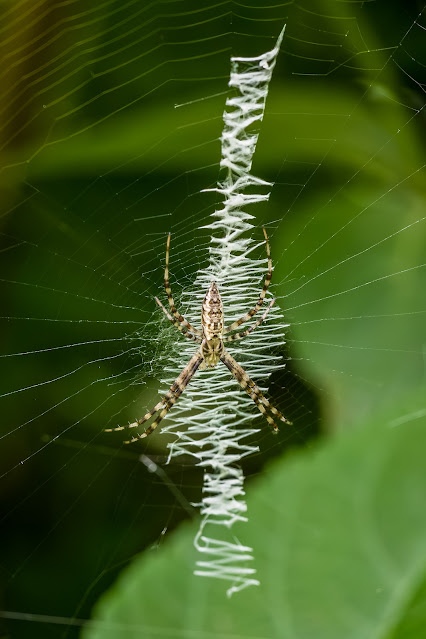 |
| Drops of morning dew sparkle on a spider's web. |
The family of spiders known for building flat, spiraled, wheel-shaped webs are called Araneidae, or the orb-weavers. They are the most common group of spiders often founds in yards, gardens, fields, and forests. In our area, those include the Black & Yellow Garden Spider (Argiope aurantia), Lichenmarked Orbweaver (Araneus bicentenarius), and Spinybacked Orbweaver (Gasteracantha cancriformis). While all of these spiders produce venom, that venom is harmless to humans but helps them to immobilize their insect prey.
Also called the Yellow Garden Spider, the Black & Yellow Garden Spider is a large spider that has an abdomen with a series of pale, yellow spots on a black background, and legs that are orange at the base, black near the tips, and often held in pairs. Females are much larger than males, with up to an inch in body length. While both appear in late summer, females can be seen through December in our area.
 |
| A Female Black & Yellow Garden Spider. |
While not quite as common, the Lichenmarked Orbweaver has an abdomen with a pattern of light green and reddish-brown markings and two small humps on front. Females can grow to one inch in body length. Its legs have alternating bands of orange and brownish-black, and the coloration on its abdomen acts as a natural camouflage against the lichen-covered branches of trees where it often rests.
 |
| Lichenmarked Orbweaver, showing its characteristic green abdomen with two humps. |
Often called crab spiders, one of our most distinctive spiders is the Spinybacked Orbweaver, a small, half-inch wide spider with a hard exoskeleton that has six spines around the edge. There are many color forms, but most are yellow or white with black or dark red spines. Males are tiny and seldom seen, but females can be seen year-round. They build their webs in the morning in shrubs or low tree branches.
 |
| Spinybacked Orbweaver, yellow form. |
 |
| Spinybacked Orbweaver, white form, showing relative size. |
Orb-weaving spiders are one of nature’s engineers, and their process to build a web is intriguing. They start by floating a line of silk on the wind to another surface. Once that line is secured, they drop another line from the center, forming a Y. The rest of the web is a series of non-sticky spirals ending with a final spiral made of sticky capture silk. The non-sticky webbing is nearly invisible, but the more visible sticky webbing is what normally traps the spider’s prey. As such, there is always a tradeoff between the visibility and stickiness of the web.
The webs built by some orb-weavers include a vertical zigzag band of highly visible silk through the center of the web. This is called the stabilimentum, and is most often found in the web of a Black & Yellow Garden Spider. While scientists are unsure of the exact purpose of this structure, theories include it posing as a lure to bring prey to the web, a warning for birds not to fly through the web, or as a way to camouflage the spider as it sits on the web.
 |
| A male Black & Yellow Garden Spider rests on the web's stabilimentum. |
Many orb-weavers build a new web on a daily basis. They often hide during the day and become more active in the evening, when they consume the old web, rest for a bit, then begin spinning a new web in the same general location. Consider all that hard work the next time you think about destroying a web!